Q1. The common mode of sexual reproduction in Chlamydomonas is
Solution
Different species of Chlamydomonas produce different types of gametes.
Sexual reproduction in Chlamydomonas may be hologamy, isogamy, anisogamy and
oogamy, but isogamy is the most simplest and common type and oogamy is the
most advanced type of sexual reproduction.
Q2. The male gamete in angiosperms is produced by
Solution
The generative cell is a cell of the male gametophyte. Generative cells divide to give rise to male gametes in angiosperms.
Q3. Protonema has which of the following characteristics?
Solution
Protonema is one of the stages of the gametophyte in the life cycle of moss. It develops from a spore. It is green, branched, filamentous and creeping.
Q4. The phylogenetic system of classification is based on
Solution
The phylogenetic classification system is based on evolutionary
relationships, and it is an acceptable method of classification at present.
Q5. Protonema occurs in the life cycle of
Solution
Protonema is the juvenile stage of Funaria. It is a branched, green
filamentous structure formed by the germination of spores under favourable
conditions.
Q6. Which one of the following is not a characteristic feature of bryophytes?
Solution
Bryophytes do not have vascular tissues. Instead, they have simple conducting strand to transport water, minerals and other food materials.
Q7. Why are bryophytes called amphibians of the plant kingdom?
Solution
Bryophytes can live in soil, but they are dependent on water for
sexual reproduction; therefore, they are called amphibians of the plant
kingdom.
Q8. Write important characteristics of gymnosperms.
Solution
Characteristics of Gymnosperms:
Ovules are not covered by ovary.
Seeds are naked.
Gymnosperms exhibit a tap root system.
Gymnosperms are heterosporous.
(Write any 3)
Q9. Gymnosperms are characterised by
Solution
In gymnosperms, seeds are naked and are not embedded in fruits.
Q10. Sporophyte dependent on gametophyte occurs in which of the following
options?
Solution
In Bryophytes, sporophyte is attached to the gametophyte. Gametophyte
is photosynthetic, and hence, sporophyte gets its nourishment from the
gametophyte.
Q11. The product of conjugation in Spirogyra or fertilisation
of Chlamydomonas is
Solution
In Chlamydomonas, the zygospore is the
resultant of isogamy, anisogamy or oogamy.
In Spirogyra, sexual reproduction occurs
through conjugation which may be scalariform or lateral. The resulting zygote
secretes a thick wall and is called zygospore.
Q12. Meiosis occurs in Funaria in
which of the following cells?
Solution
In funaria, antherozoids swim towards the archegonium. One of the
antherozoids fuses with the archegonium to form the zygote. With the
formation of zygote, the sporophytic phase begins, during which the zygote
undergoes meiosis to form sporogonium.
Q13. Find the odd one out with respect to haplontic life cycle.
Solution
In the haplontic life cycle, the plant
body is gametophyte and independent. The sporophyte is not free-living and is
dependent on the gametophyte. It is observed in majority of green algae such
as Ulothrix, Spirogyra and
Chlamydomonas.
Q14. State any two important features of dicotyledons.
Solution
Important features of dicotyledons:
Seeds of dicotyledons show two cotyledons.
Leaves of dicotyledons show reticulate
venation.
Vascular bundles are arranged in concentric
circles.
Q15. The plant body is the thallus in
Solution
The thallus is an undifferentiated mass of cells. In algae, the plant
body consists of numerous undifferentiated cells (tissue-level organisation
is absent).
Q16. In Pinus, if the pollen grain has 6 chromosomes,
then its endosperm will have
Solution
In gymnosperms such as Pinus, both pollen grains and endosperm are
haploid and are formed before fertilisation. If the pollen grain has haploid
number of chromosomes equal to 6, then its endosperm will also have 6
chromosomes.
Q17. The nutrient medium is made semi-solid by adding
Solution
Agar is the substance obtained from red algae. It is obtained from Gelidium and Gracilaria.
Q18. Bryophytes are distinguishable from fungi in having which of the following characteristics?
Solution
In fungi, spores are thin walled and flagellate but in bryophytes the antherozoids and archegonia are well jacketed.
Q19. Consider the following statements with respect to characteristic features of the kingdom.
(A) In Animalia, the mode of nutrition is autotrophic.
(B) In Monera, the nuclear membrane is present.
(C) In Protista, the cell type is prokaryotic.
(D) In Plantae, the cell wall is present.
Of the above statements,
Solution
(A) In Animalia, the mode of nutrition is heterotrophic.
(B) In Monera, the nuclear membrane is absent.
(C) Protists are unicellular eukaryotes.
(D) In Plantae, the cell wall is present.
Q20. Brown algae have a characteristic pigment of
Solution
Fucoxanthin is a carotenoid pigment which imparts a brown colour to algae. It is sensitive to shorter wavelengths of light. Hence, species of brown algae are found in shallow water.
Q21. What does a pollen chamber in a gymnosperm represents?
Solution
In gymnosperms, the pollen chamber represents a cavity in the ovule in which pollen grains are stored after pollination.
Q22. Agar is commercially received from
Solution
Red algae Gelidium and Gracilaria are used for the commercial
production of agar. Agar is used in jellies. It is also used in microbiology
techniques to grow microbes.
Q23. Bryophytes depend on water because water is required for which of the
following processes?
Solution
Bryophytes require a layer of water on
the soil so that the antherozoids can swim to the archegonium. Once they
reach the archegonium, one of the antherozoids fuses with the egg cell to
form the zygote.
Q24. A common feature between bryophytes and pteridophytes is which of the options listed below?
Solution
Multicellular sex organs with sterile jacket are a common feature of bryophytes and pteridophytes.
Q25. In ferns, meiosis occurs when
Solution
In ferns, sexual reproduction takes place
through spores which are borne in sporangia.
Q26. The ‘wing’ of Pinus seed is derived from the
Solution
The wings of seeds in Pinus
are thin, membranous, diploid and develop jointly
from the basal upper surface of ovuliferous scales and the outer layer of the
integument of the ovule.
Q27. What is anisogamous fusion?
Solution
Anisogamous fusion is the fusion between two gametes which are
dissimilar in size.
Q28. In the life cycle of Funaria, spores are the beginning of which of the following terms?
Solution
In the life cycle of Funaria, spores are the beginning of the gametophytic generation. Spores germinate to give rise to the gametophyte.
Q29. Sago of Cycas is given to patients with stomach disorders because it is
Solution
Sago is a pure starch extract in the liquid state. In the solid state, it is in the form of granules. The sago obtained from Cycas circinalis is easily digestible. It is a major staple food for people from New Guinea.
Q30. Phycology deals with the study of
Solution
Phycology is the branch of biology which deals with the study of algae.
It is also known as algology.
Q31. The moss plant has which of the following characteristics?
Solution
Gametophyte is the dominant stage in the moss plant.
Q32. The gametophytic generation is dominant in which of the following
terms?
Solution
In Bryophytes, the sporophyte is attached to the photosynthetic
gametophyte.
Q33. Explain the
modes of reproduction in Ulothrix.
Solution
In Ulothrix,
reproduction may occur by the following methods:
1. Vegetative
reproduction by fragmentation or by formation of different types of spores.
2. Asexual
reproduction by flagellated zoospores.
3. Sexual
reproduction by the isogamous, anisogamous or oogamous fusion of gametes.
Q34. In which of the following would you place the plants with vascular
tissue lacking seeds?
Solution
Pteridophytes are terrestrial, vascular and seedless plants.
Q35. Floridean starch occurs in
Solution
In Rhodophyceae (red algae), food is stored in the form of floridean starch. Its grains are stored outside the chloroplast.
Q36. Resin and turpentine are products of
Solution
Turpentine is obtained from pine resin.
Q37. Name the plant body which produces gametes by mitosis.
Solution
Gametophyte
Q38. A multicellular jacketed female sex organ of bryophytes is called which of the following terms?
Solution
Archegonium is flask-shaped and jacketed. Its lower part is swollen and the anterior part is apical in shape. It produces egg cells.
Q39. Mosses and ferns are found in moist and shady places because both have which of the following requirements?
Solution
Mosses lack vascular tissues. Also both mosses and ferns require water to carry out sexual reproduction.
Q40. A plant in which sporophytic generation is
represented by zygote is
Solution
Chlamydomonas reproduces asexually through
the formation of zoospores and sexually through gametes. Gametes fuse to
produce a diploid zygote representing the sporophytic
generation.
Q41. Pinus differs from mango in having
Solution
Gymnosperms are known as seeded plants
without flowers because their ovules are not covered and lie naked on the
surfaces of specialised leaves arranged into cones.
Q42. In gymnosperms, the haploid structures are
Solution
In gymnosperms, the megaspore is the first cell of the female
gametophyte and undergoes repeated divisions to form a multicellular female
gametophyte which serves as an endosperm. Microspores or pollen grains are
the first cell of the male gametophyte and are haploid in nature.
Q43. Fusion of two gametes which are dissimilar in size is termed
Solution
Anisogamy is the fusion between two gametes which are either dissimilar in size or in both size and morphology. It is observed in Chlamydomonas. Oogamy is a type of anisogamy.
Q44. In Chlorophyceae, sexual reproduction occurs by
Solution
In Chlorophyceae, sexual reproduction occurs by isogamy, anisogamy or oogamy.
Isogamy: The gametes are similar in size and shape. These gametes are not classified as male or female. They are noted as ‘+’ and ‘−’ strains.
Anisogamy: It is the fusion between two gametes which are either dissimilar in size or in both size and morphology. It is observed in Chlamydomonas.
Oogamy: Oogamy is a type of anisogamy. The male gamete is smaller in size than the female gamete.
Q45. In plants, haploid as well as diploid cells undergo mitosis. Hence,
during the life cycle of a sexually reproducing plant, there is an
alternation of generation between gametophyte and sporophyte.
Name the dominant phase seen in the life cycle
of gymnosperms.
Name three types of life cycles shown by the
plants.
What is the difference between the life cycles
of bryophytes and pteridophytes?
What value do you learn from the life cycles of
plants?
Solution
Sporophyte is the dominant phase seen in the
life cycle of gymnosperms.
The three types of life cycles shown by the
plants are haplontic, diplontic and haplodiplontic.
In bryophytes, the gametophyte represents the
dominant phase. In pteridophytes, the sporophyte represents the dominant
phase
All individuals have different ways of
implementing their values and culture. Irrespective of these, all should
be respected and allowed to live with dignity.
Q46. Which is the photosynthetic phase in the life cycle of ferns?
Solution
Diploid sporophyte
Q47. Write the name of the species of moss which provides peat?
Solution
Sphagnum
Q48. Male cone of Pinus is made of
Solution
Microsporophylls contain sporangia in which haploid microspores develop. Microsporophylls in pine are present on male strobili.
Q49. Write the pigments found in members of the Phaeophyceae group of
algae.
Solution
Chlorophyll a, chlorophyll c, carotenoids and xanthophyll
(fucoxanthin).
Q50. What are pyrenoids?
Solution
Pyrenoids are food storage bodies found in members of Chlorophyceae.
Q51. In Chlorophyceae, sexual reproduction occurs by
Solution
Chlorophyceae are one of the classes of green algae which
show three types of sexual reproduction—isogamy, anisogamy and oogamy.
Q52. Describe the plant body of brown algae.
Solution
The
plant body of brown algae is attached to the substratum by a holdfast.
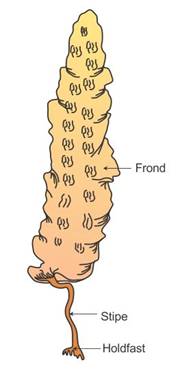 It has
a stalk called stipe.
The frond is a leaf-like photosynthetic organ of the plant body.
It has
a stalk called stipe.
The frond is a leaf-like photosynthetic organ of the plant body.
 It has
a stalk called stipe.
The frond is a leaf-like photosynthetic organ of the plant body.
It has
a stalk called stipe.
The frond is a leaf-like photosynthetic organ of the plant body.
Q53. Gemma for vegetative reproduction occurs in which of the following plants?
Solution
Gemma are the green buds in Funaria that develop along the axis of the leaves. They help in vegetative reproductive. When gemma detach from the parent plant, they develop into a new Funaria.
Q54. Holdfast, stipe and frond constitute the plant body in case of
Solution
In Phaeophyceae, the plant body is attached to the substratum by holdfast. The stalk is known as stipe. The frond is a leaf-like photosynthetic organ.
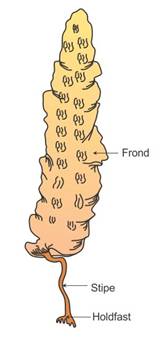

Q55. Define flower.
Solution
A flower is a special reproductive structure in angiosperms in which
the pollen grains and ovules develop.
Q56. Ulothrix filaments produce
Solution
Ulothrix is a green alga which reproduces
sexually by the union of isogametes which are motile, biflagellate and morphologically
similar gametes. Approximately 8-32 isogametes are produced from a mother
cell.
Q57. Define the
following terms:
1. Isogamous
fusion
2.
Anisogamous fusion
3. Oogamous fusion
Solution
1. Isogamous fusion: Fusion between two gametes of
similar size is called isogamous fusion.
2. Anisogamous fusion: Fusion between two gametes
which are dissimilar in size is called anisogamous fusion.
3. Oogamous fusion: Fusion between one large,
non-motile female gamete and a smaller, motile male gamete is called oogamous
fusion.
Q58. Which plant group
produces spores and embryos but lacks vascular tissues and seeds?
Solution
Bryophytes consist of a thalloid body and are
attached by hair-like structures called rhizoids. These lack vascular tissue
and require water at the time of fertilisation. The haploid gametophyte
(formation of spores for sexual reproduction) alternates with the diploid
sporophyte (formation of spores for asexual reproduction).
Q59. Name the pigment present in the members of Rhodophyceae.
Solution
R-phycoerythrin
Q60. Distinguish between haplontic and diplontic life cycles.
Solution
Haplontic Life Cycle
Diplontic Life Cycle
Gametophytic phase is dominant.
Sporophytic phase is dominant.
Sporophyte is in the form of a diploid zygote.
Gametophyte is single celled or few celled.
Q61. Draw diagrams of a) Volvox b) Chara
Solution
a) Volvox:
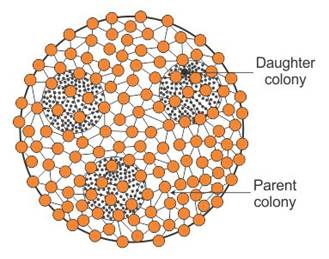 b) Chara:
b) Chara:
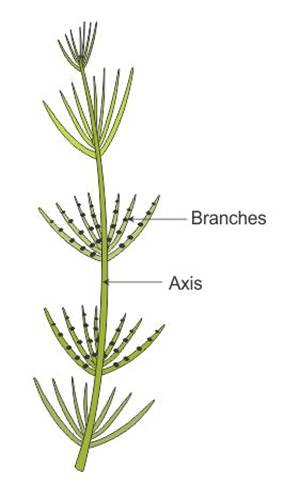
 b) Chara:
b) Chara:

Q62. What is protonema?
Solution
Protonema is the first stage in the gametophytic phase of a moss.
Q63. Which ones are non-vascular?
Solution
Bryophytes are
non-vascular plants. They possess conducting strands for the absorption of
water and minerals.
Q64. What are sporophylls?
Solution
Sporophylls are leaf-like appendages in pteridophytes which bear
sporangia.
Q65. Name two algae used to prepare agar.
Solution
Gelidium and Gracilaria
Q66. What is unique about bryophytes?
Solution
Sporophytes remain attached to the gametophyte. Gametophytes are photosynthetic and nourish the sporophytes.
Q67. Name the diploid phase in the plant with a haplontic life cycle.
Solution
The zygote is the diploid phase in a plant with a haplontic life cycle.
Q68. Ribbon-shaped chloroplasts occur in
Solution
Spirogyra is the name of the genus which is derived from its spiral shaped chloroplasts.
Q69. Which of the following is called amphibians of the plant kingdom?
Solution
Though bryophytes grow on damp soil, rocks, walls, on the banks of
ponds, on the bark of trees, they require a layer of water on the surface of
soil for the following reasons:
Movement of male gametes to reach archegonia
For the dehiscence of antheridia
Because they lack conducting tissues, they
require free water for absorption
Q70. State the uses of algae
Solution
Uses of algae:
Algae help to increase the level of dissolved
oxygen in their immediate environment.
Species of algae such as Porphyra, Laminaria
and Sargassum are used as food.
Hydrocolloids produced by algin and carrageen
are used commercially.
Commercial product agar is obtained from
certain species of algae.
Examples: Gelidium
and Gracilaria
Agar is used in the preparation of ice creams
and jellies. It is also used to grow microbes in laboratories.
Species such as Chlorella and Spirulina are
rich in proteins and thus used as food supplements.
Q71. Define pollination.
Solution
Pollination is the transfer of pollen grains, after their dispersal,
from the anthers to the stigma of the pistil of the same flower or different
flower of the same species.
Q72. Name the dominant phase in a plant with a haplontic life cycle.
Solution
The gametophyte is the dominant phase in a plant with a haplontic life
cycle.
Q73. The first vascular plants are which of the following plants?
Solution
Pteridophytes are considered first seedless, terrestrials vascular
plants containing xylem and phloem.
Q74. Name any two algae which exhibit a haplodiplontic life cycle.
Solution
Ectocarpus, Polysiphonia
Q75. Write the components of the cell wall of Rhodophyceae and Phaeophyceae.
Solution
Group of algae
Components of cell wall
Rhodophyceae
Cellulose, pectin and polysulphate esters
Phaeophyceae
Cellulose and algin
Q76. Name an alga which shows the diplontic life cycle.
Solution
Fucus
Q77. Name the process by which haploid spores are produced by the
sporophyte.
Solution
Meiosis
Q78. Distinguish between monocotyledons and dicotyledons.
Solution
Monocotyledons
Dicotyledons
1. Seeds have single cotyledon.
1. Seeds have two cotyledons.
2. Leaves show parallel venation.
2. Leaves show reticulate venation.
Q79. State any one feature of conifers which helps to reduce water loss.
Solution
Presence of sunken stomata.
Q80. Describe the events which occur during the life cycle of an angiosperm.
Solution
During pollination, the pollen grains germinate on the stigma.
This results in the formation of pollen tube which grows through the style and reaches the ovule.
When the pollen tube enters the sac, two male gametes are discharged.
One male gamete fuses with the egg cell and forms a zygote.
The second male gamete fuses with the diploid secondary nucleus and produces the triploid primary endosperm nucleus (PEN).
Because the fusion occurs twice, it is called double fertilisation.
The zygote develops into an embryo, while the primary endosperm nucleus develops into endosperm.
The endosperm provides nourishment to the developing embryo.
The synergids and antipodals of the egg apparatus degenerate after fertilisation.
At the end of this cycle, ovules develop into seeds which give rise to a new plant (sporophyte) while ovaries develop into fruits.
Q81. Which plant is commonly known as maiden hair fern?
Solution
Adiantum is commonly known as maiden
hair fern.
Q82. What are coralloid roots?
Solution
Coralloid roots are specialised roots found in Cycas which are
associated with nitrogen-fixing cyanobacteria.
Q83. Write any two differences between Chlorophyceae and Rhodophyceae.
Solution
Chlorophyceae
Rhodophyceae
1. Food is stored in the form of pyrenoids.
1. Food is stored in the form of floridean starch.
2. Chlorophyll a and b are present.
2. Red pigment called r-phycoerythrin is present.
Q84. Give any two examples of plants which exhibit a haplontic life cycle.
Solution
Chlamydomonas and Spirogyra
Q85. Explain how Laminaria is different from Porphyra.
Solution
Laminaria
Porphyra
It is a brown alga and belongs to the group Phaeophyceae.
It is a red alga and belongs to Rhodophyceae.
Food is stored in the form of mannitol.
Food is stored in the form of floridean starch.
Pigments present are chlorophyll a, chlorophyll b, carotenoids and fucoxanthin.
Pigment present is r-phycoerythrin.
Sexual reproduction may be isogamous, oogamous or anisogamous.
Sexual reproduction is oogamous.
Gametes possess flagella.
Gametes do not possess flagella.
Q86. Describe the structure of the vegetative cell of Chlorophyceae.
Solution
The vegetative cell has a cell wall made of cellulose.
The cell wall is covered with a gelatinous coating of algin.
The protoplast of vegetative cells contains plastids, vacuole and nucleus.
Q87. Draw a labelled diagram of the lifecycle of an angiosperm.
Solution
Lifecycle of an angiosperm:
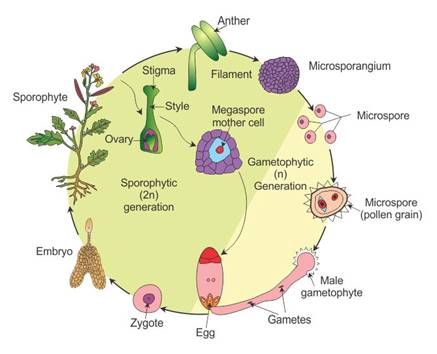

Comments
Post a Comment